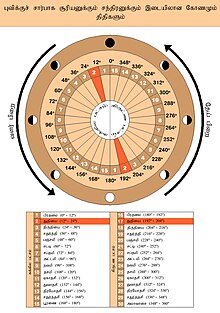Dvitiya: Difference between revisions
Appearance
Content deleted Content added
Chronikhiles (talk | contribs) |
|||
| (3 intermediate revisions by 3 users not shown) | |||
| Line 1: | Line 1: | ||
{{Short description|Second day of a lunar fortnight in the Hindu calendar}} |
{{Short description|Second day of a lunar fortnight in the Hindu calendar}} |
||
[[File:Thithi-Thuthiyai.jpg|thumb|right|alt=Dvitiya|Dvitiya]] |
|||
'''Dvitiya''' ({{ |
'''Dvitiya''' ({{Langx|sa|द्वितीय|translit=Dvitīya}}) also referred to as '''Beej''' ({{Langx|sa|बीज|translit=Bīja}}) and '''Dooj''' ({{Langx|sa|दुजा|translit=Dujā}}) is the [[Sanskrit]] word for "second",<ref>{{Cite book |last=Selin |first=Helaine |url=https://books.google.com/books?id=GzjpCAAAQBAJ&dq=dvitiya+second+seventeenth&pg=PA806 |title=Encyclopaedia of the History of Science, Technology, and Medicine in Non-Western Cultures |date=2013-11-11 |publisher=Springer Science & Business Media |isbn=978-94-017-1416-7 |pages=806 |language=en}}</ref> and is the second day of the lunar fortnight (''[[Paksha]]'') of the [[Hindu calendar]].<ref>{{Cite book |last=Turner |first=R. L. |url=https://books.google.com/books?id=UX_AeDYzhBQC&dq=dvitiya+second+day&pg=PA381 |title=A Comparative Dictionary of the Indo-Aryan Languages |date=1999 |publisher=Motilal Banarsidass Publishers |isbn=978-81-208-1665-7 |pages=381 |language=en}}</ref><ref>{{Cite book |last=Klostermaier |first=Klaus K. |url=https://books.google.com/books?id=8CVviRghVtIC&dq=dvitiya+hindu+month&pg=PA493 |title=A Survey of Hinduism: Third Edition |date=2010-03-10 |publisher=State University of New York Press |isbn=978-0-7914-8011-3 |pages=493 |language=en}}</ref> Each Hindu month has two dvitiya days, being the second day of the "bright" (''Shukla'') and of the "dark" (''Krishna'') fortnights respectively. Dvitiya occurs on the second and the seventeenth day of each month. |
||
==Occasions== |
==Occasions== |
||
* [[Bhau-beej|Bhratri Dvitiya (Bhai Dooj/Bhau Beej)]], the last day of the [[Diwali|Deepavali]] festival, occurs on the dvitiya of the month of [[Kartika (month)|Kartika]].<ref>{{cite web |url=https://www.businessinsider.in/india/news/bhai-dooj-puja-time-date-all-schedule-you-need-to-know/articleshow/71787467.cms |title=Bhai Dooj puja time, date, all schedule you need to know {{!}} Business Insider India |website=www.businessinsider.in |url-status=dead |archive-url=https://web.archive.org/web/20191028054423/https://www.businessinsider.in/india/news/bhai-dooj-puja-time-date-all-schedule-you-need-to-know/articleshow/71787467.cms |archive-date=2019-10-28}} </ref> |
* [[Bhau-beej|Bhratri Dvitiya (Bhai Dooj/Bhau Beej)]], the last day of the [[Diwali|Deepavali]] festival, occurs on the dvitiya of the month of [[Kartika (month)|Kartika]].<ref>{{cite web |url=https://www.businessinsider.in/india/news/bhai-dooj-puja-time-date-all-schedule-you-need-to-know/articleshow/71787467.cms |title=Bhai Dooj puja time, date, all schedule you need to know {{!}} Business Insider India |website=www.businessinsider.in |url-status=dead |archive-url=https://web.archive.org/web/20191028054423/https://www.businessinsider.in/india/news/bhai-dooj-puja-time-date-all-schedule-you-need-to-know/articleshow/71787467.cms |archive-date=2019-10-28}} </ref> |
||
* ''Phulerā Dooj/Dvitiya'': It is celebrated on Shukla Paksha Dvitiya of [[Phalguna|Phalgun]] month and is quite popular in [[Braj Region|Braj region]]. This festival falls between two Hindu festivals commemorating |
* ''Phulerā Dooj/Dvitiya'': It is celebrated on Shukla Paksha Dvitiya of [[Phalguna|Phalgun]] month and is quite popular in [[Braj Region|Braj region]]. This festival falls between two Hindu festivals commemorating spring season i.e. [[Vasant Panchami|Vasanta Panchami]] and [[Holi]]. On this day holi is played using flowers. The [[Murti|Murtis]] of Hindu Devi-Devatas are decorated with flowers and flower canopy known as ''Phulera''. As per [[Naradiya Purana|Narada Purana]], Lord [[Shiva]] is worshipped on this day with white colored fragrant flowers and an ornamental floral canopy is used for decorating His vigraha. On same day, in Radha Krishna temples vermillion are offered and flower holi is played in their remembrance.<ref>{{Cite news |date=2016-03-09 |title=Phulera Dooj and its significance |work=The Times of India |url=https://timesofindia.indiatimes.com/religion/rituals-puja/phulera-dooj-and-its-significance/articleshow/68206779.cms |access-date=2023-03-30 |issn=0971-8257}}</ref><ref>{{Cite news |date=2023-02-21 |title=Phulera Dooj: Read more to know about the significance and rituals conducted during this festival |work=The Economic Times |url=https://economictimes.indiatimes.com/news/new-updates/phulera-dooj-know-the-significance-and-rituals-conducted-during-this-festival/articleshow/98092700.cms?from=mdr |access-date=2023-03-30 |issn=0013-0389}}</ref> |
||
* [[Ramdevpir-dooj]] or Ramdevpir-beej, the second day of [[Shukla paksha]] of [[Bhaadra|Bhadra]] month is celebrated as the birthday of [[Ramdevji]] in northwestern India. |
* [[Ramdevpir-dooj]] or Ramdevpir-beej, the second day of [[Shukla paksha]] of [[Bhaadra|Bhadra]] month is celebrated as the birthday of [[Ramdevji]] in northwestern India. |
||
Latest revision as of 14:18, 6 November 2024

Dvitiya (Sanskrit: द्वितीय, romanized: Dvitīya) also referred to as Beej (Sanskrit: बीज, romanized: Bīja) and Dooj (Sanskrit: दुजा, romanized: Dujā) is the Sanskrit word for "second",[1] and is the second day of the lunar fortnight (Paksha) of the Hindu calendar.[2][3] Each Hindu month has two dvitiya days, being the second day of the "bright" (Shukla) and of the "dark" (Krishna) fortnights respectively. Dvitiya occurs on the second and the seventeenth day of each month.
Occasions
[edit]- Bhratri Dvitiya (Bhai Dooj/Bhau Beej), the last day of the Deepavali festival, occurs on the dvitiya of the month of Kartika.[4]
- Phulerā Dooj/Dvitiya: It is celebrated on Shukla Paksha Dvitiya of Phalgun month and is quite popular in Braj region. This festival falls between two Hindu festivals commemorating spring season i.e. Vasanta Panchami and Holi. On this day holi is played using flowers. The Murtis of Hindu Devi-Devatas are decorated with flowers and flower canopy known as Phulera. As per Narada Purana, Lord Shiva is worshipped on this day with white colored fragrant flowers and an ornamental floral canopy is used for decorating His vigraha. On same day, in Radha Krishna temples vermillion are offered and flower holi is played in their remembrance.[5][6]
- Ramdevpir-dooj or Ramdevpir-beej, the second day of Shukla paksha of Bhadra month is celebrated as the birthday of Ramdevji in northwestern India.
References
[edit]- ^ Selin, Helaine (2013-11-11). Encyclopaedia of the History of Science, Technology, and Medicine in Non-Western Cultures. Springer Science & Business Media. p. 806. ISBN 978-94-017-1416-7.
- ^ Turner, R. L. (1999). A Comparative Dictionary of the Indo-Aryan Languages. Motilal Banarsidass Publishers. p. 381. ISBN 978-81-208-1665-7.
- ^ Klostermaier, Klaus K. (2010-03-10). A Survey of Hinduism: Third Edition. State University of New York Press. p. 493. ISBN 978-0-7914-8011-3.
- ^ "Bhai Dooj puja time, date, all schedule you need to know | Business Insider India". www.businessinsider.in. Archived from the original on 2019-10-28.
- ^ "Phulera Dooj and its significance". The Times of India. 2016-03-09. ISSN 0971-8257. Retrieved 2023-03-30.
- ^ "Phulera Dooj: Read more to know about the significance and rituals conducted during this festival". The Economic Times. 2023-02-21. ISSN 0013-0389. Retrieved 2023-03-30.
